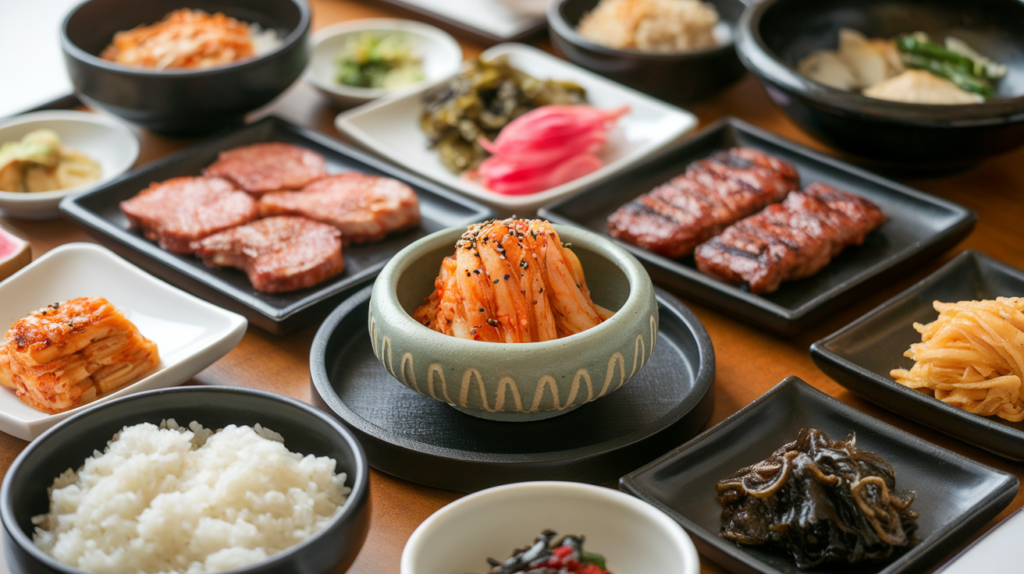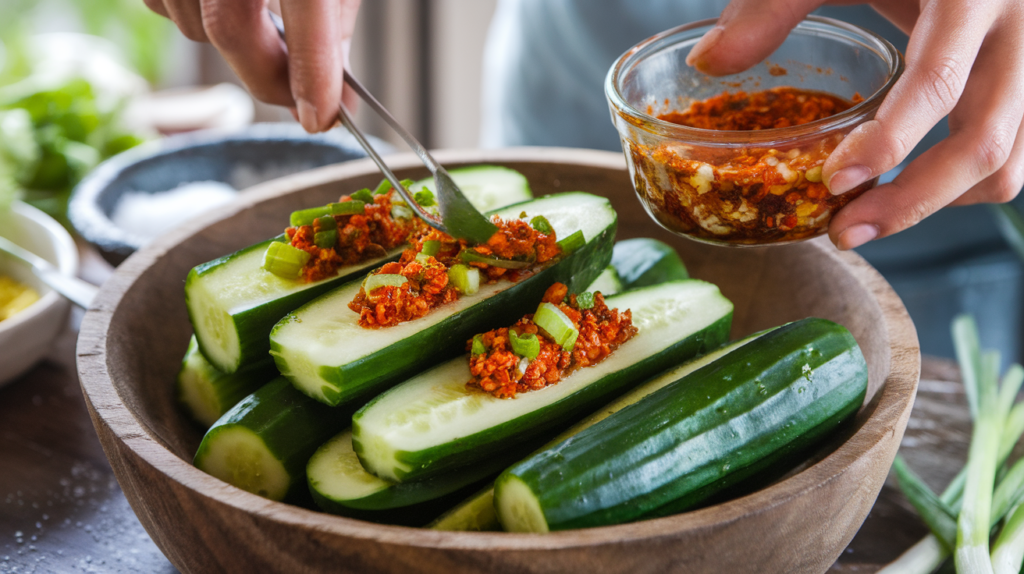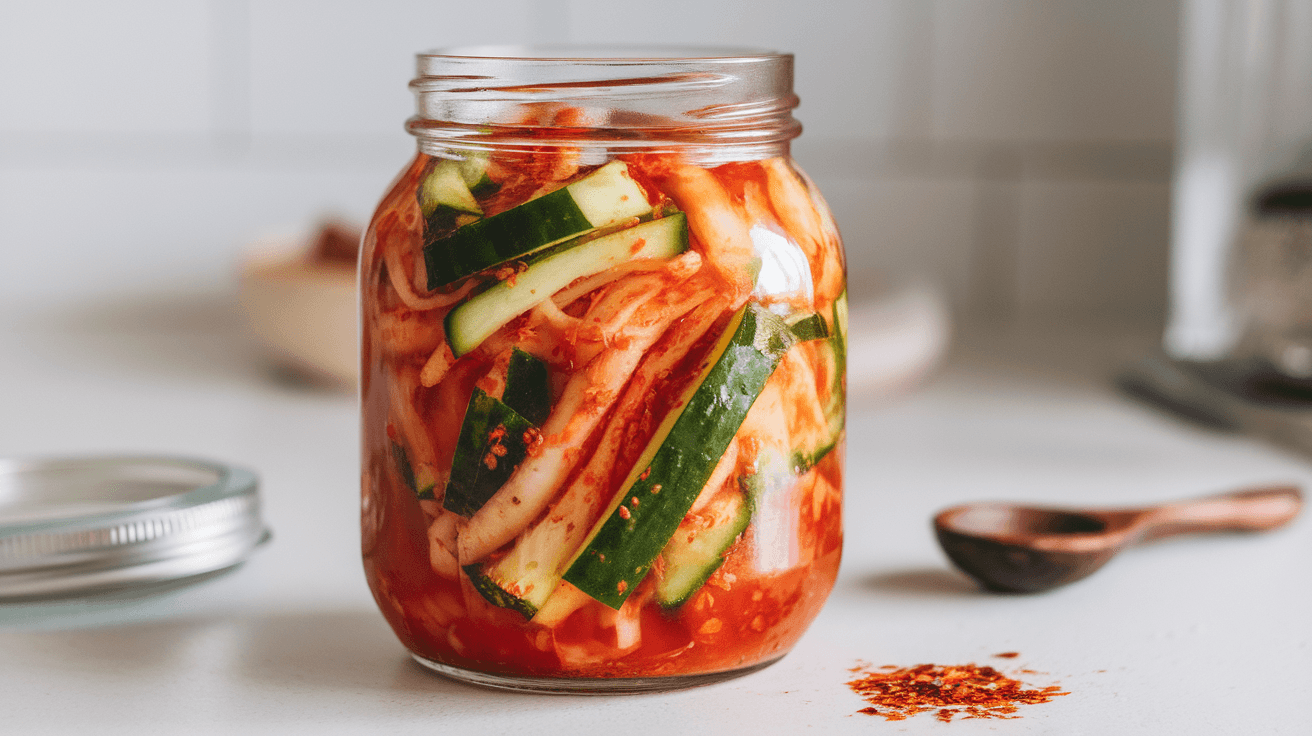Introduction
Kimchi, a traditional Korean dish, has taken the global food scene by storm, and among its many varieties, cucumber kimchi stands out as a refreshing and versatile option. Known for its tangy, spicy, and slightly sweet flavors, cucumber kimchi offers a lighter alternative to its cabbage-based counterpart, making it perfect for warm weather or those seeking a crisp, fresh side dish.
This fermented delicacy combines the crunch of cucumbers with the robust flavors of garlic, chili powder, and other seasonings, delivering a probiotic-rich treat that’s as nutritious as it is delicious. Whether you’re new to Korean cuisine or a seasoned kimchi lover, learning about Fermented cucumber recipe is a culinary adventure worth exploring.
Why Is Cucumber Kimchi So Popular?
Cucumber kimchi’s popularity lies in its versatility and ease of preparation. Unlike traditional kimchi, which may take weeks to ferment, cucumber kimchi can be ready to enjoy in just a few hours or days, depending on your taste preferences. Its crisp texture and refreshing taste make it a staple in Korean households and a must-try for anyone curious about fermented foods

What is Kimchi and its Varieties
Kimchi is a quintessential part of Korean cuisine, known for its bold flavors and remarkable versatility. This traditional fermented dish typically combines vegetables with a flavorful mix of seasonings like chili powder, garlic, ginger, and fish sauce. While napa cabbage and radish are the most common ingredients, the art of kimchi-making extends far beyond these staples, with cucumber kimchi being a notable and beloved variation.
Brief History of Kimchi
The origins of kimchi date back over 3,000 years, evolving through Korea’s agricultural and culinary history. Initially created as a method of preserving vegetables for the winter months, kimchi has become a symbol of Korean culture and identity. Its preparation varies by region and season, leading to a rich diversity of flavors and ingredients.
Common Types of Kimchi
- Napa Cabbage Kimchi (Baechu Kimchi): The most iconic type, made with cabbage, radish, and a spicy seasoning blend.
- Radish Kimchi (Kkakdugi): Cubed radish fermented with spices, offering a crunchy texture and a bold flavor.
- White Kimchi (Baek Kimchi): A milder, non-spicy version that uses a lighter seasoning mix.
- Cucumber Kimchi (Oi Sobagi): A refreshing variation made with cucumbers stuffed with seasonings, perfect for quick fermentation.
Unique Features of Cucumber Kimchi
What sets Kimchi with cucumbers apart from other varieties is its texture and preparation. The cucumbers absorb the flavorful marinade while retaining their signature crunch. It’s a popular summer dish due to its cooling effect and pairs wonderfully with both rice and meat dishes. Its relatively quick preparation time also makes it a convenient choice for busy individuals.
Korean cucumber dish strikes a balance between tangy, spicy, and slightly sweet flavors, making it an ideal introduction to kimchi for those new to fermented foods.
Health Benefits of Cucumber Kimchi
Cucumber kimchi isn’t just a delightful culinary experience—it’s also a nutritional powerhouse. This traditional Korean dish is packed with essential nutrients, probiotics, and health-boosting compounds that make it a valuable addition to your diet. From improving digestion to supporting immunity, Korean cucumber dish offers numerous health benefits for food enthusiasts and health-conscious individuals alike.
Rich in Probiotics
One of the standout benefits of cucumber kimchi is its abundance of probiotics. The fermentation process encourages the growth of beneficial bacteria, such as Lactobacillus, which supports gut health. A balanced gut microbiome is linked to improved digestion, enhanced nutrient absorption, and even better mental health. Adding Korean cucumber dish to your meals can help promote a healthy digestive system.
Low-Calorie and Nutrient-Dense
Korean cucumber dish is naturally low in calories, making it an excellent choice for those looking to manage their weight without sacrificing flavor. Cucumbers are hydrating and rich in vitamins like vitamin K, vitamin C, and potassium. The added spices and seasonings contribute antioxidants and anti-inflammatory properties, creating a nutrient-dense side dish or snack.
Boosts Digestive Health
The combination of probiotics, fiber, and enzymes in cucumber kimchi makes it a boon for digestion. The probiotics help maintain a healthy balance of gut bacteria, while the fiber supports regular bowel movements. Additionally, the fermentation process enhances the bioavailability of nutrients, ensuring your body gets the most out of every bite.
How to Make Cucumber Kimchi at Home
Creating cucumber kimchi at home is simpler than you might think. With a handful of fresh ingredients and some basic kitchen tools, you can enjoy this flavorful Korean dish in no time. Whether you’re an experienced cook or a novice, this step-by-step guide will help you make a delicious batch of the recipe.
Ingredients Needed
Before you start, gather the following ingredients for a traditional Korean cucumber dish recipe:
- Fresh cucumbers: 4–6 small, firm cucumbers (Persian or Kirby cucumbers work best).
- Salt: Coarse sea salt for salting the cucumbers.
- Garlic: 4–6 cloves, finely minced or grated.
- Ginger: 1-inch piece, peeled and grated.
- Chili powder: Korean chili flakes (gochugaru) for authentic flavor.
- Fish sauce: 2–3 tablespoons (optional for vegetarians).
- Green onions: Chopped into 1-inch pieces.
- Carrots: Thinly julienned for added texture (optional).
- Sugar: A small pinch to balance the flavors.
Step-by-Step Preparation

- Prepare the Cucumbers: Wash the cucumbers thoroughly and cut them into halves or quarters lengthwise, leaving the base intact so they fan out. Sprinkle the cucumbers with coarse sea salt and let them sit for 20–30 minutes to draw out excess moisture. Rinse them gently to remove excess salt.
- Make the Marinade: In a mixing bowl, combine garlic, ginger, chili flakes, fish sauce (or soy sauce for vegetarians), sugar, and a splash of water to create a thick paste. Adjust the spice level by adding more or less chili powder.
- Stuff the Cucumbers: Carefully stuff the marinade into the cucumber slits, ensuring the seasoning reaches deep into the vegetable. Add green onions and carrots for additional flavor and texture.
- Ferment the Kimchi: Place the stuffed cucumbers into a clean, airtight container or a glass jar. Press them down gently to remove air pockets. Leave the container at room temperature for 6–12 hours to kickstart fermentation.
- Store in the Refrigerator: After the initial fermentation period, transfer the container to the refrigerator. The mix will continue to ferment, and its flavor will deepen over the next few days. You can enjoy it fresh or after it has developed more complexity.
Tips for the Best Results
- Use fresh cucumbers: Opt for firm, unblemished cucumbers for the best texture.
- Control fermentation time: Adjust the fermentation period to suit your taste preferences—shorter for fresh flavor, longer for tangier kimchi.
- Experiment with seasonings: Feel free to customize the recipe with additional spices, sesame seeds, or a splash of vinegar.
Making cucumber kimchi at home is a rewarding experience that allows you to experiment with flavors and tailor the dish to your liking. Plus, you’ll enjoy the satisfaction of creating an authentic Korean delicacy from scratch.
Traditional vs. Modern Recipes
Cucumber kimchi has evolved over the years, reflecting both traditional Korean culinary practices and modern adaptations. Whether you prefer the authenticity of age-old recipes or the creativity of contemporary twists, cucumber kimchi offers something for everyone. Let’s explore the differences between traditional and modern recipes and how you can customize this dish to suit your tastes.
Traditional Methods Explained
In traditional Korean households, cucumber kimchi, or oi sobagi, is often prepared with minimal ingredients to preserve the natural flavors of the cucumbers. The focus is on achieving a balance of salty, spicy, and umami flavors through a simple yet effective combination of cucumbers, garlic, ginger, Korean chili powder (gochugaru), and fish sauce.
- Fermentation: Traditional recipes emphasize the importance of fermentation, allowing the cucumbers to develop complex flavors over several days.
- Ingredients: Classic recipes avoid substitutions, using Korean chili flakes and fish sauce to achieve authentic taste.
- Texture: The cucumbers are salted and lightly pressed to enhance their crunchiness while ensuring they absorb the marinade.
Traditional cucumber kimchi is often served as a side dish during meals, offering a burst of flavor that complements staples like rice, soups, and grilled meats.
offer unique benefits, allowing you to enjoy the best of both worlds.
Storage and Shelf Life
Proper storage is key to maintaining the flavor, texture, and safety of your cucumber kimchi. Since cucumber kimchi has a higher water content than other types of kimchi, its storage needs and shelf life are slightly different. Here’s how to store your homemade cucumber kimchi and enjoy it at its peak.
How to Store Cucumber Kimchi

Once you’ve prepared your cucumber kimchi, follow these steps to ensure it stays fresh and flavorful:
- Use an Airtight Container: Transfer the kimchi into a clean, airtight glass or plastic container to prevent exposure to air, which can accelerate spoilage.
- Refrigerate Immediately: Unlike cabbage-based kimchi, cucumber kimchi is often best refrigerated soon after preparation to preserve its crisp texture and prevent over-fermentation.
- Avoid Overfilling: Leave some space at the top of the container to allow for slight expansion as the kimchi ferments.
- Keep Away from Direct Light: Store the container in the coldest part of your refrigerator, away from light and heat sources.
Cucumber Kimchi FAQ
Cucumber kimchi is a fascinating dish that often raises questions among new and experienced food enthusiasts. Below, we answer some of the most frequently asked questions to help you understand and enjoy this delightful Korean delicacy.
1. Is cucumber kimchi spicy?
Yes, cucumber kimchi is typically spicy due to the use of Korean chili powder (gochugaru). However, you can adjust the spice level by reducing the amount of chili powder or substituting it with milder alternatives. This makes cucumber kimchi adaptable to various taste preferences.
2. Can I use any type of cucumber to make cucumber kimchi?
While you can use most cucumbers, smaller varieties like Persian cucumbers or Kirby cucumbers are ideal. They have fewer seeds, thinner skins, and a crisp texture that holds up well during the fermentation process. Avoid using cucumbers with thick, waxy skins unless peeled.
3. How long does it take to make cucumber kimchi?
Cucumber kimchi is one of the quickest kimchi varieties to prepare. It can be enjoyed fresh within a few hours or lightly fermented after 6–12 hours at room temperature. For deeper flavors, allow it to ferment for 1–2 days in the refrigerator.
4. Can I make cucumber kimchi without fish sauce?
Yes! Fish sauce is a common ingredient in traditional recipes, but it can be substituted with soy sauce, tamari, or even miso paste for a vegetarian or vegan version. These alternatives provide a similar umami flavor while keeping the dish plant-based.
5. Why does my cucumber kimchi taste too salty?
Excess saltiness can occur if the cucumbers were not rinsed thoroughly after salting. To fix this, try soaking the salted cucumbers in water for a few minutes before stuffing them with the marinade. Additionally, balance the flavors by adding a pinch of sugar or vinegar to the marinade.
6. Can cucumber kimchi be used in other recipes?
Absolutely! Korean cucumber dish can enhance various dishes. It pairs wonderfully with rice, noodles, grilled meats, or seafood. You can also use it as a topping for burgers, tacos, or salads to add a burst of flavor and crunch.
7. What are the health benefits of eating cucumber kimchi regularly?
Eating cucumber kimchi regularly provides several health benefits, including improved digestion, enhanced gut health, and a boost to the immune system. It’s also low in calories and packed with nutrients like vitamin C, vitamin K, and antioxidants, making it a healthy addition to your diet.
8. How do I prevent cucumber kimchi from becoming too soft?
Cucumber kimchi may lose its crunchiness if over-fermented or stored too long. To maintain its texture, refrigerate it immediately after the initial fermentation and consume it within 1–2 weeks. Using firm, fresh cucumbers and salting them properly also helps retain their crispness.
9. Can I reuse the marinade from cucumber kimchi?
Yes, the leftover marinade can be reused to flavor other vegetables or as a base for soups and stews. However, ensure it has been stored properly and has not been contaminated by utensils during serving.
10. Is cucumber kimchi suitable for children?
Cucumber kimchi can be suitable for children if the spice level is adjusted to their preference. Reduce or omit the chili powder and ensure the flavor is mild enough for their tastes. Its crunchy texture often appeals to young eaters.
Conclusion
Cucumber kimchi is a delightful blend of flavor, texture, and health benefits that brings the essence of Korean cuisine to your table. Its quick preparation, adaptability, and unique taste make it an excellent choice for both beginners and seasoned kimchi enthusiasts.
Whether you stick to traditional recipes or experiment with modern variations, cucumber kimchi is a versatile dish that can elevate any meal. Packed with probiotics, antioxidants, and essential nutrients, it’s not just a side dish—it’s a wholesome addition to your diet.
So why not give it a try? Whether you’re savoring it fresh or pairing it with your favorite dishes, cucumber kimchi is sure to become a staple in your kitchen. Embrace the world of fermentation and discover the joys of homemade cucumber kimchi today!

